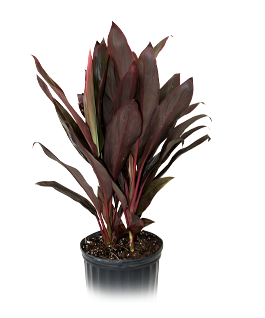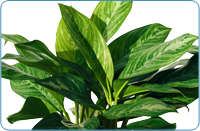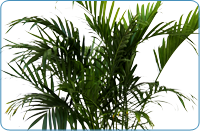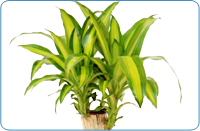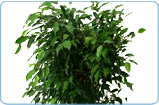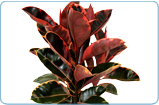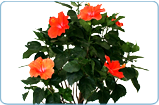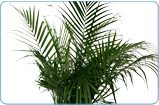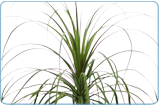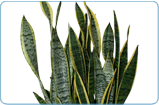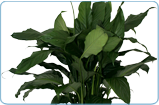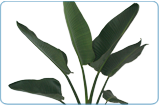Spider Mites:
Spider Mites look like tiny dots on the underside of your plant leaf. They usually live in large groups, so you will definitely see more
than one of these tiny dots in a group on the plant. Spider Mites are known as such from the silk webbing that they leave behind on infested
leaves. This presence of webbing is the best indication that your plant may be infested. Another good indication that your plant might be
infested with this pest or another is by studying your plants leaf. If you begin to notice the leaves are covered a lot of yellow pin pricks
that may be a good indication.
Spider mites usually become a problem on outdoor plants after certain insecticides have been sprayed that may have killed the natural enemies
of the mite. The best thing to do when dealing with Spider Mites is to find an insecticidal soap that you can use to wipe down the leaves. It is
advised that you test out the insecticidal soap on a small portion of the plant before applying it to the whole plant. For indoor plants the best
course of action is to remove or isolate the plant from the home to minimize possible spreading to other nearby plants. If only a small portion of
the plant is infested, clip that section and dispose of the clippings. If the entire plant is infested and the plant holds no sentimental value best
thing to do is dispose of the plant. If you want to try and save the plant do not waste your time with pesticides as they usually won’t have any
effect on this pest. Treat the plant with an insecticidal soap every couple of weeks to help kill or keep the mites in control.
Mealy Bugs:
Mealy bugs are white, waxy creatures that live in large colonies usually on the undersides of the leaves and/or around leaf joints. The bug is about
1/10th of an inch and has the look of cotton. Similar to other pests a sure sign that your plant is infested is if you observe that the leaves of your
plant seem dry or weak (dropping). If you notice those signs the first course of action would be to isolate the infested plant from all other plants
within your home. After that use a strong spray bottle with water in order to try to wash off the colonies from your plant, or wipe off the infestation
with cotton buds dipped in rubbing alcohol. Take note that this may not work to get rid of all the Mealy Bugs at one time, so keep the plant away from
others while you monitor it for more insects. Another option is to buy the Mealy Bug’s natural predator called the Mealybug destroyer (Cryptolaemus
montrouzieri) which is a species of lady bug. This is an option for heavily infested plants, but is probably not practical unless you have a large number
of infested plants. Once the Mealybugs have been killed and consumed the Mealybug destroyer will die off from a lack of a food source.
Fungus Gnats:
The adult fungus gnats are gray or dark-gray, fly-like insects about 1/8 inch long. They are attracted to light and when present in your house, swarm
over the windows because of the natural light. The immature form of the Fungus Gnat, which lives in the soil, are thin whitish maggots with a jet black
head, and attain a length of about 1/4 inch. The maggots are likely to be found in soils with quantities of decaying plant. The damage caused by these
pest’s are usually occur while they are in their maggot form as they will bury themselves in the soil and feed on the roots of the plant. The gnats
themselves are more of a pest then an issue to the plant.
Best way to keep your plant free of fungus gnat maggots is to avoid overwatering your plant. In the event that your plant is already infested with this
pest, use an insecticide drench and apply it to the potting to control the problem. For the adults use of a labeled and targeted insecticide should assist
in destroying them. If you want to avoid the use of chemicals to kill the larvae, by allowing the soil to dry out completely between watering they should
die out.
Scales:
There are many species of scales that are commonly found in indoor house or greenhouse plants. Some species of the insect can have an armored shell like
covering that will protect its entire form while others will have none at all. Those with the waxy shell can have its protection removed by simply scraping
it away. It is easiest to tell the difference as the soft scales (no armored protection) produce honeydew while the armored scales will not. Scales feed on
your plant by sucking on the plant’s sap. This will promote poor growth which will eventually stunt the growth of your plant. It can also lead to your
plant being infested to sooty mold.
The most practical thing to do for your first attempt at cleaning up your plant from its infestation is to use soap and water to wash off the leaves and
stems. If your plant is heavily infested, you can try an insecticide spray schedule on your plant that involves 2 to 3 sprays a week every two weeks. It is
usually best to discard the plant however before the infestation can spread.
Thrips:
There are many sub species of Thrips that can infest common indoor house hold plants. The insect is barely visible to the naked eye. In its adult form the
pest is a brownish, black color with light markings on its body. The larvae can be a light yellow to orange color with black excrement on their backs. When a
plant that this pest inhabits is disturbed the adult forms it can be seen to fly or run. This insect will feed on the juices of the plants leaves and/flowers.
The damage that is left behind is random streaked silvered areas of the plant that are speckled with little black dots of excrement. The plants leaves and/or
flowers may be blotched or drop away from the plant.
Labeled insecticides that state they can handle thrips are the best option for removal. Try a daily spray of 4 times a day for 4 days on both the plant and
the soil to get rid of this pest.





